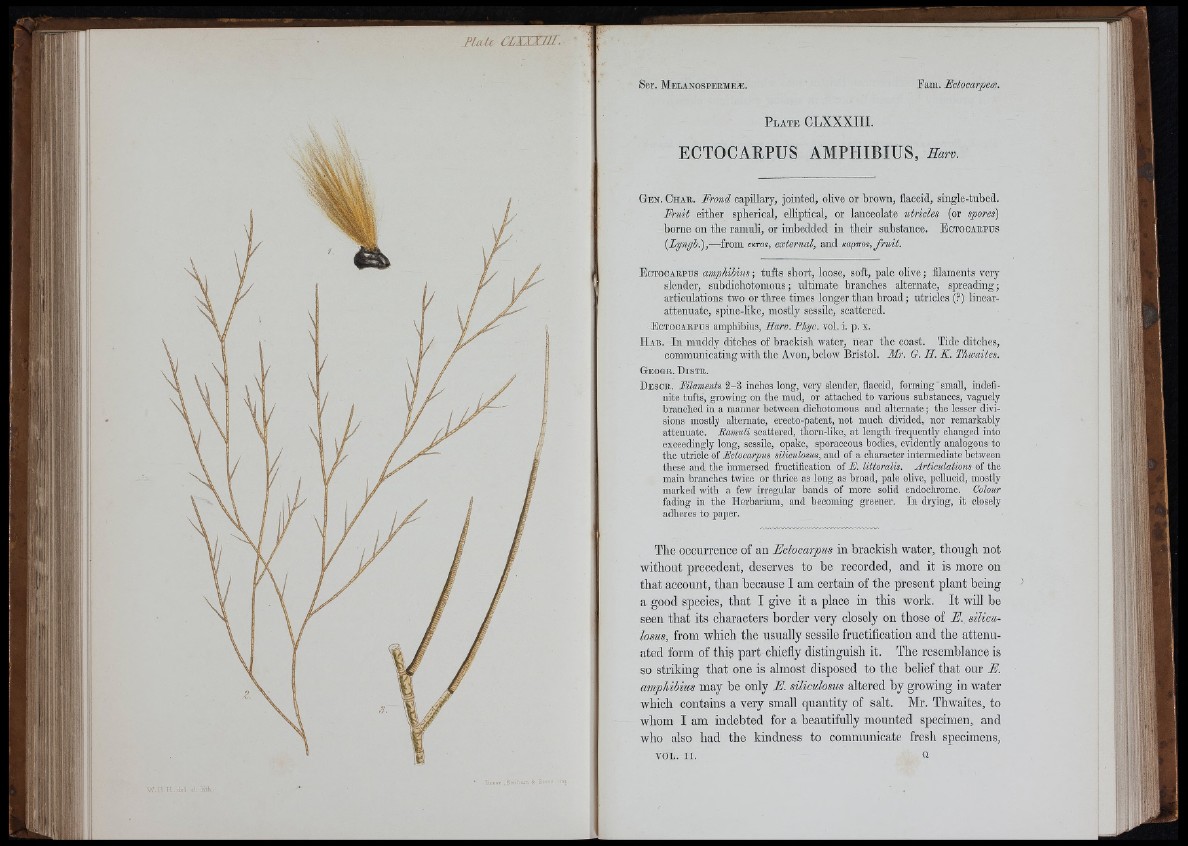
Fla Le OLXJiX TTI.
- i ¿s
A . i l . Y I c i r( l.ÇK,
Sor. M e lanospeem eæ. Fam. Fctocarpeoe.
P l a t e CLXXXIII.
ECTOCARPUS AMPHIBIUS, Harv.
I s l
G e n . Ch a r . Frond capillary, jomted, olive or brown, flaccid, single-tnbed.
F ru it either spherical, elliptical, or lanceolate utricles (or spores)
borne on th e ramuli, or imbedded in th e ir substance. E ctocarpus
(Lgngb.),— from cktos, external, and Kapjros,j
E ctocaepus anphihius ; tu fts short, loose, soft, pale olive ; filaments very
slender, subdichotomous; ultimate branches alternate, spreading;
articulations two or tliree times longer th an b ro ad ; utricles (?) linear-
attenuate, spine-like, mostly sessile, scattered.
E ctocarpus amphibiiis, Ilarv. Pliye. vol. i. p. x.
H a b . I n muddy ditches of brackish water, near th e coast. 'E de ditches,
communicating w ith th e Avon, below Bristol. Mr. 0 . II. K. Thwaites.
Geogr. D is t e .
D e sc r. Filaments 3-8 inches long, very slender, flaccid, forming small, indefinite
tufts, gTowing on the mud, or attached to various substances, vaguely
branched in a manner between dichotomous and alternate ; the lesser divisions
mostly alternate, erecto-patent, not much divided, nor remarkably
attenuate. Bamuli scattered, thorn-like, a t length frequently changed into
exceedingly long, sessile, opake, sporaceous bodies, evidently analogous to
the utricle of Fctocarpus siliculosus, and of a character intermediate between
these and the immersed fructification of E. littoralis. Articulations of the
main branches twice or thrice as long as broad, pale olive, pellucid, mostly
marked with a few irregular hands of more solid endochrome. Colour
fading in the Herbarium, and becoming greener,
In diying, it closely
adheres to paper.
The occurrence of an Ectocarpus in brackish water, though not
without precedent, deserves to be recorded, and it is more on
that account, than because I am certain of the present plant being
a good species, that I give it a place in this work. It will be
seen that its characters border very closely on those of E., siliculosus,
from which the usually sessile fructification and the attenuated
form of this part chiefly distinguish it. The resemblance is
so striking that one is almost disposed to the belief that our E.
amphibius may be only E. siliculosus altered by growing in water
which contains a very small quantity of salt. Mr. Thwaites, to
whom I am indebted for a beautifully mounted specimen, and
who also had the kindness to communicate fresh specimens,
VOL. II. a
' t i i i